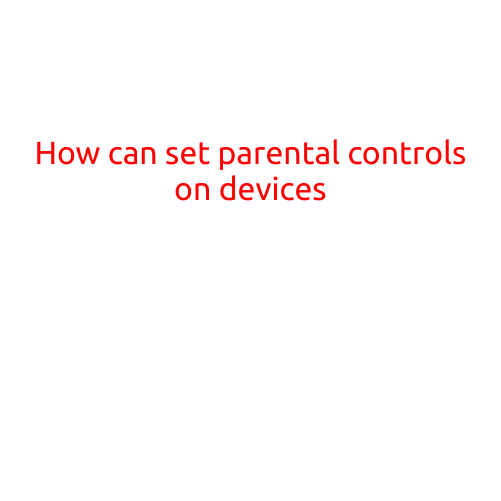
How to Set Parental Controls on Devices
As a parent, it’s natural to worry about your child’s online activities and ensure they stay safe while using devices. With the rise of smartphones, tablets, and computers, it’s more important than ever to set parental controls to limit access to inappropriate content, set boundaries, and monitor their online behavior. In this article, we’ll walk you through the steps to set parental controls on devices.
Why Set Parental Controls?
Setting parental controls is crucial for several reasons:
- Cyberbullying: Protect your child from online harassment and bullying.
- Inappropriate Content: Block access to explicit images, videos, and websites.
- Online Predators: Prevent children from communicating with online predators.
- Screen Time: Establish limits on device usage to promote healthy habits.
- Privacy: Keep personal information and location protected.
Setting Parental Controls
The process of setting parental controls varies depending on the device and operating system. Here’s a general guide to help you get started:
Android Devices
- Go to Settings.
- Scroll down and select “Google” or “Parental Controls” (depending on your device).
- Toggle “Set up parental controls” to the ON position.
- Create a PIN or password to set up the controls.
- Configure settings for:
- Online content filtering (e.g., block explicit websites).
- App restrictions (e.g., limit app installation).
- Screen time limits (e.g., set daily time limits).
iOS Devices
- Go to Settings.
- Scroll down and select “Screen Time” (on iOS 12 and above).
- Toggle “Screen Time” to the ON position.
- Set up a Screen Time passcode.
- Configure settings for:
- Content restrictions (e.g., block explicit websites).
- App restrictions (e.g., limit app installation).
- Screen time limits (e.g., set daily time limits).
- Downtime (e.g., set a specific time range for device use).
PC and Mac Laptops
- Install a parental control software (e.g., Kaspersky Safe Kids, Net Nanny).
- Set up an account and follow the installation process.
- Configure settings for:
- Website blocking (e.g., block explicit websites).
- App restrictions (e.g., limit app installation).
- Parental reporting (e.g., receive updates on your child’s online activity).
- Time limits (e.g., set a schedule for device use).
Additional Tips
- Regularly Monitor: Keep an eye on your child’s online activities and adjust settings as needed.
- Open Communication: Talk to your child about online safety and set expectations.
- Stay Up-to-Date: Regularly update device software and parental control software to ensure you have the latest features and protection.
- Buddy System: Use a family sharing plan or two-step verification to ensure your child’s account is secure.
Conclusion
Setting parental controls is a simple way to protect your child from online threats and ensure a safe and healthy digital environment. By following these steps and tips, you can take control of your child’s device use and provide a more secure and responsible online experience.





